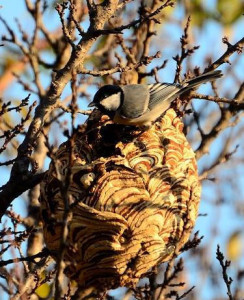
Parus major (Great tit)
Parus major, commonly known as the Great Tit, is one of the most common and adaptable bird species found in the Great Himalayan National Park (GHNP). Easily recognizable by its striking black and white head, yellow-green body, and bold markings, the Great Tit is a favorite for birdwatchers. It is an energetic and social bird, frequently seen in mixed-species flocks, especially during the colder months when it forages for food.
The Great Tit’s varied diet and remarkable adaptability make it a year-round resident of GHNP, where it can be spotted in a wide range of habitats, from dense forests to woodland edges.
Habitat and Distribution in GHNP
In the Great Himalayan National Park, Parus major is found at altitudes ranging from 1,200 to 2,500 meters, with a preference for broadleaf forests, oak woods, and rhododendron thickets. This species thrives in the temperate and subtropical climates of GHNP, especially in the Tirthan and Sainj valleys, where it is often spotted near streams and tree-lined trails.
The Great Tit is highly adaptable and can be found in both subtropical and temperate zones within the park. During the winter months, it may descend to lower elevations, taking advantage of food availability near human settlements.
| Common name | Great Tit |
| Scientific name | Parus major |
| Family | Paridae (Tits) |
| Description | Glossy uncrested black head, glistening white cheek-patches, grey back and whitish underparts with a broad black band down the centre. Sexes alike. Frequents well-wooded localities, but not dense humid forest. Singly, pairs or parties, often hunting in association with other small insectivorous birds. Very active. Cings to sprigs, flowering stems and tree-trunks, etc., upside down and in other acrobatic positions in search of food – insects, their eggs and larvae, flower buds, fruit, kernels of small nuts and seeds. The latter are held down underfoot and hacked open with the strong conical bill. Joyous sweeching notes uttered while moving about. In the breeding season the male has a loud, clear, whistling song: whee-chichi, whee-chichi, etc. Resident and partial migrant Plains, and hills to about 2000 m. |
Behavior and Diet
The Great Tit is primarily insectivorous, feeding on insects, spiders, and seeds, although it may also consume small fruits and berries. Known for its clever foraging techniques, it is often seen using its strong beak to break open seeds or pry insects from the bark of trees. Great Tits are active and social, often foraging in mixed-species flocks, especially during the winter months when food is scarce.
The Great Tit is also recognized for its loud and varied calls, which it uses to communicate with other members of its group, particularly in dense forested environments. It nests in cavities, often using tree holes or old woodpecker nests.
Conservation Significance
Parus major is listed as a species of Least Concern due to its widespread distribution and ability to adapt to various habitats. However, like all species, it benefits from the GHNP’s conservation efforts, which ensure the park’s diverse ecosystems remain intact.
By protecting its forest habitats and limiting deforestation, GHNP continues to support healthy populations of the Great Tit, along with many other bird species that depend on the park’s resources.



